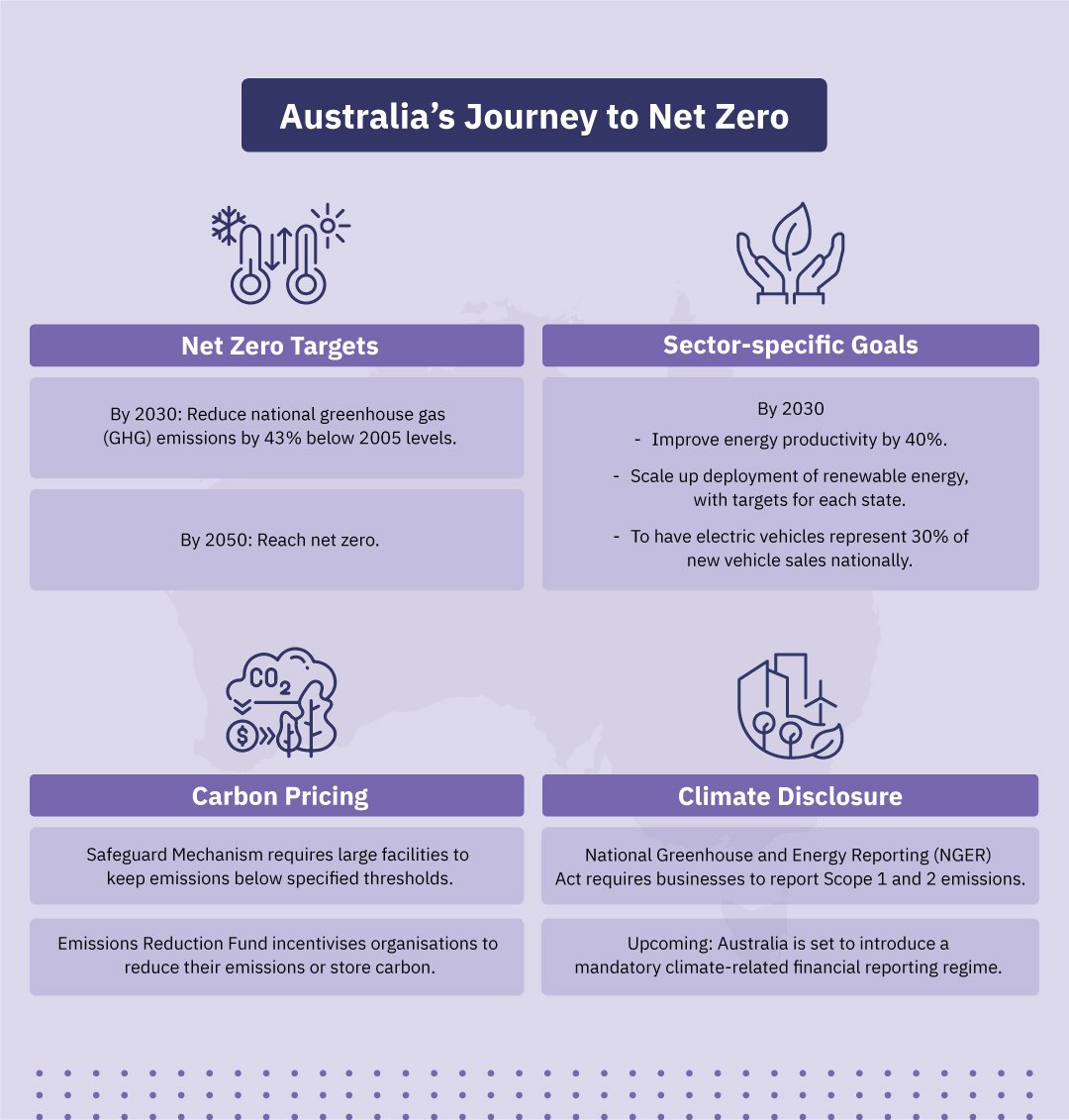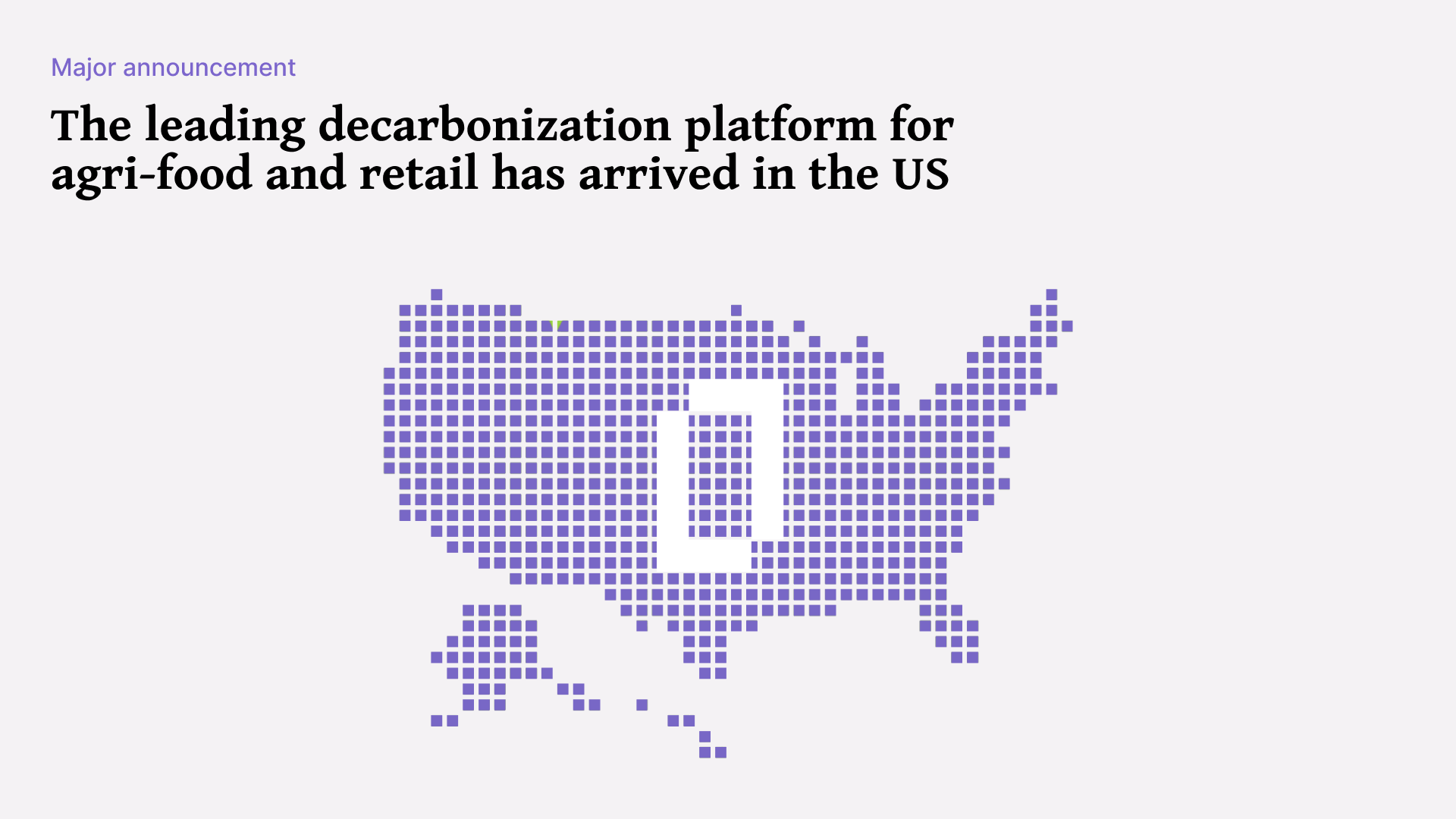As sustainability takes center stage on a global level, Australia has emerged as a regional leader in the Asia-Pacific region, committing to establishing climate regulations which are unprecedented in this region. Businesses which operate in Australia must navigate an increasingly complex regulatory framework, which presents multiple potential opportunities and risks. By understanding the implications of net zero legislation, carbon pricing mechanisms and climate disclosure regulations, businesses can gain a competitive edge while contributing to a sustainable future. Terrascope can help businesses uncover the path towards climate resilience.

National Targets and Net Zero Legislation
In 2022, the new Labor Government doubled Australia’s 2030 emissions reduction target by committing to reduce its greenhouse gas (GHG) emissions by 43% below 2005 levels by 2030. It also set the goal of reaching net zero by 2050.
The national target is also supported at the state and sectoral level. For example, Australia targets to improve its energy productivity by 40% by 2030. It also aims to scale up its deployment of renewable energy – by achieving 100% renewable energy deployment in the Australian Capital Territory and Tasmania, and 50% renewable deployment in Queensland, Victoria and Northern Territory, by 2030. It aims to have electric vehicles represent 30% of new vehicle sales by 2030 nationally, and 50% for New South Wales and Victoria.
These ambitious climate targets make it vital for businesses to prepare accordingly. These represent an opportunity for businesses to use decarbonization to expand their revenue streams. For example, businesses could pivot towards offering more sustainable products or services. On the other hand, businesses should start taking concrete actions to decarbonize their operations in line with Australia’s national and sectoral targets, to avoid facing regulatory or reputational challenges in the future.
Carbon Pricing
Australia has implemented several carbon pricing instruments, which play a pivotal role in supporting Australia’s net zero targets. One of these instruments is the Safeguard Mechanism, which requires large facilities to ensure that their emissions do not exceed specified ‘baselines’ (i.e. thresholds). Facilities which have produced more emissions than these ‘baseline’ thresholds must offset their emissions. From July 2023, facilities that overachieve on their baseline (i.e. produce less emissions than their allocated thresholds) are allowed to issue credits. This makes the Safeguard Mechanism an emissions trading scheme (ETS). Over time, Australia will tighten the ‘baselines’, in alignment with its 2030 targets.
Concurrently, Australia has implemented the Emissions Reduction Fund, which is a voluntary scheme that incentivises organisations to adopt new practices and technologies to reduce their emissions or store carbon. Participating organisations can earn 1 Australian carbon credit unit (ACCU) for each 1tCO2e stored or avoided by a project. These ACCUs can be sold to generate income.
These carbon pricing regulations represent both opportunities and risks for Australian businesses. They could potentially increase costs for Australian businesses, for example if their electricity suppliers are unable to switch to renewable electricity sources quickly enough. On the other hand, businesses can seize this opportunity to present a strong financial case to push for investing in decarbonization levers early, which may reduce business costs over the longer term. Moreover, businesses could use the aforementioned carbon pricing instruments to sell credits and generate revenue.
Climate Disclosure
The third strategy which supports Australia’s climate ambitions lies in driving transparency and accountability among businesses. In this regard, Australia is looking to implement carbon disclosure regulations which are rigorous, internationally aligned and credible which mandate the measurement and reporting of carbon emissions. These regulations facilitate the transition to a low-carbon economy by encouraging businesses to reduce their GHG emissions, as well as by enabling investors and financial institutions to make more informed decisions on capital allocation.
Most Australian businesses are already voluntarily producing sustainability reports, and can expect to produce more robust reports to meet investors’ expectations who are demanding better quality and internationally-comparable disclosures along with these soon-to-be mandatory reporting regulations.
The Australian government is expected to pass the Treasury Laws Amendment (Financial Market Infrastructure and Other Measures) Bill 2024 by August of 2024 which will see mandatory and relatively stringent climate reporting compared to the voluntary reporting present today. Businesses can be expected to start reporting with financial years starting as early as 1 Jan 2025 in accordance with the framework as shown in the table below (see fig 1). NGER reporters are already required to report greenhouse gas emissions, energy production and energy consumption and will fall under Group 1 or 2.

Fig. 1: Phases in timeline and criteria of the Treasury Laws Amendment
(Financial Market Infrastructure and Other Measures) Bill 2024
Scope 3 emissions are required to be reported from a company’s second reporting year on top of the immediate mandatory disclosure of Scope 1 & 2 emissions. Scope 3 emissions make up the majority of a company’s total emissions and are the hardest to accurately measure and calculate out. Current TCFD guidelines will be replaced with more granular and additional specific disclosures, according to the Australian Accounting Standards Board (AASB) which closely follow the standards set out by the International Sustainability Standards Board (ISSB). Namely the IFRS S1 (Sustainability-related financial disclosures) and the more targeted IFRS S2 (Climate-related financial disclosures). THE IFRS S2 requires more details such as current company actions, future strategies, identified risks and opportunities. Qualitative and quantitative data are also mandated when disclosing climate-related risks, requiring companies to use an approach that is commensurate with their circumstances.
In anticipation of these mandatory disclosures, even companies who do not fall under any of the aforementioned categories should look to embark on emission accounting if they have not already. When Scope 3 emissions reporting becomes a requirement of Group 1 companies, this will lead to increased customer demand for emission data from their value chain, spilling over to smaller companies who in turn have to disclose their own emissions data. Given the short runway to measure Scope 1, 2 and 3 emissions accurately before the bill becomes law, it is imperative companies take preemptive action now. Failure to comply with this marked shift in climate reporting requirements may pose reputational damage, criminal liability, and civil liability, thus highlighting the necessity for companies to look into trusted decarbonization measurement platforms like Terrascope.
By adopting robust emissions measurement practices, companies not only mitigate environmental impact but also bolster their reputation. Furthermore, compliance with evolving regulations not only minimizes legal risks but also fosters trust among investors, customers and regulators. By embracing internationally-comparable disclosure frameworks, businesses can enhance credibility and competitiveness in the global marketplace. In doing so, they pave the way for a more sustainable future while simultaneously driving efficiency and cost-effectiveness within their operations.
The Terrascope Solution
Terrascope is an end-to-end decarbonization platform that helps businesses measure and manage their carbon emissions. Using machine learning and AI capabilities, Terrascope assimilates data from across complex supply chains and fills gaps in data to provide accurate and comprehensive carbon emission calculations across Scopes 1, 2 and 3. By working with Terrascope, businesses can get a thorough understanding of their carbon emissions, broken down by product, geography, process, and more. This, in turn, can drive actionable change in operations and can also help them avoid legal or regulatory penalties.
In particular, the Australian Government’s proposal to require businesses to make climate-related financial reporting spell some major changes for Australian businesses, and Terrascope can help facilitate this transition.



